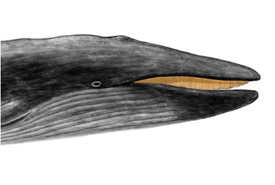An ode to whale (Part Two)

Blue whale (Illustration by Denise Wong)
morning! /
he takes in the salt /
retiring to depth /
(Inspired by Eden Killer Whale Museum)
Facts:
Baleen, also known as whalebone, is not bone. Baleen is the bristly drapery that lines the mouth of a dozen species of whales, including the exalted humpback whale, the behemoth blue whale, the elusory Omura’s whale and the fin whale (or Ischmael’s “Whalebone whale”). Like nuptial tubercles, baleen is made of keratin.
If you are a whale without teeth, then baleen is your utensil of choice. You first take an enormous gulp of water and let your blubbery mouth expand like an accordion. Then, with your tongue, push the water back out into the ocean through the baleen sieve. There should be krill leftover on the baleen strands that you can lap up with your tongue.
When whaling was a prolific industry, there were many fascinatingly creative uses of baleen (both the bristles and the “plates” to which the bristles were attached): brooms, umbrellas, buggy whips, frames for eyeglasses, chess sets, fishing line, hair brushes and baskets. In need of a corset? There’s a baleen for that. Don’t have a “ditty box” to hold your pick-up sticks? There’s a baleen for that. The most ornate use of baleen is scrimshaw — art made from whale parts. And my favourite use of baleen, a toboggan!
This post originally appeared on Natalie's blog, Phish Doc.


